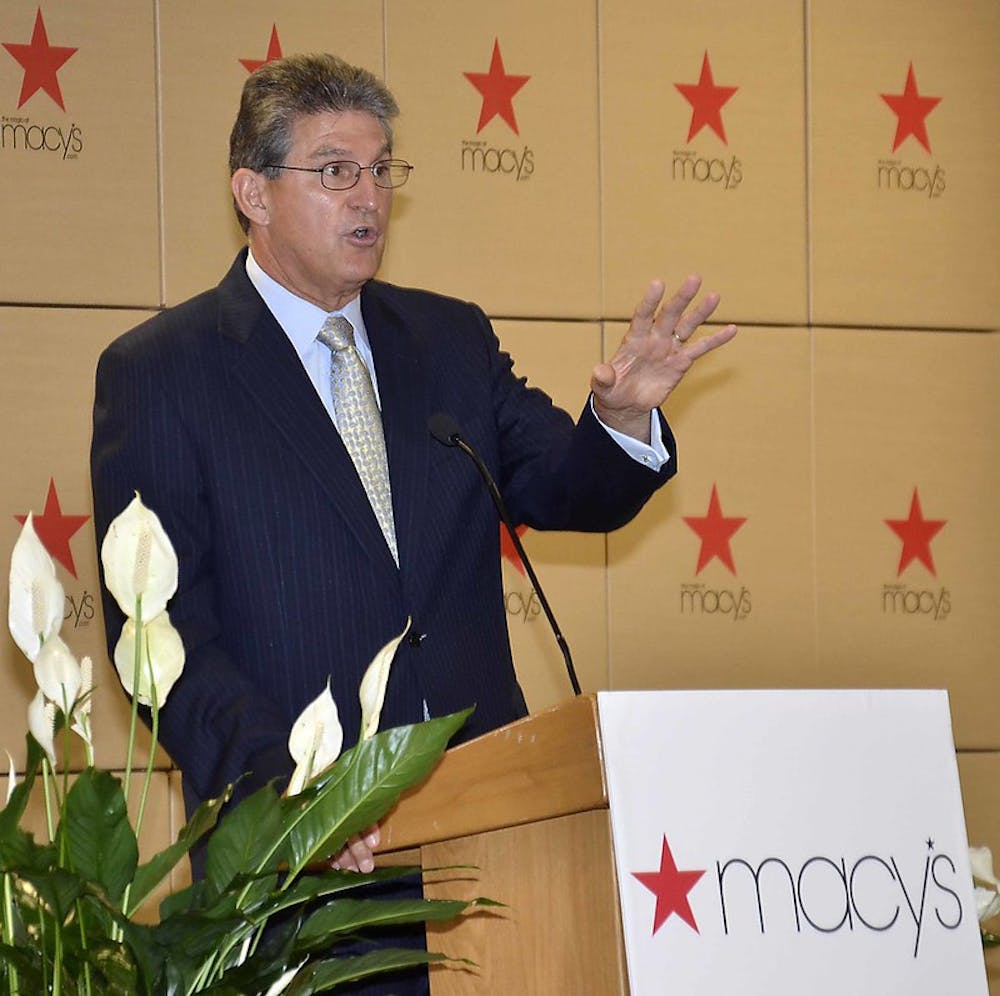By Connor Carlin
Correspondent
Congressional Democrats have a lot of big plans but limited chances of getting them out the door. Top on the agenda is President Biden's $3.5 trillion infrastructure bill, and next are bills on voting rights and immigration reform. These proposals have proven popular with the public, despite attempts by Republicans to gin up opposition. So, why aren’t they going through?
There are several reasons these bills have stalled. However, there are two reasons in particular I want to talk about here. Enter West Virginia Senator Joe Manchin and Arizona Senator Kyrsten Sinema, the so-called centrist Democrats holding up the process.
One of these senators, Manchin, is easy to understand. Even before Democrats took the Senate back in 2020, Manchin was still a Democrat from West Virginia. To emphasize what that means, here are some figures: Donald Trump won the state in 2020 by 40 percent, and currently, Manchin is the only Democrat representing West Virginia at a federal level. Manchin is essentially the only Democrat who can win in West Virginia, serving as its governor before becoming senator and stacking up a voting record which he touts as “representing West Virginia, not Washington.” He’s a Democrat who opposes abortion, he’s a member of the National Rifle Association, and, above all, he valiantly defends West Virginia coal production against the scourge of environmentalism. It also doesn’t hurt that he’s developed a vast network of coal companies since the 1980s, bringing in millions to his personal fortune. Many of these companies have long histories of pollution and work safety violations.
No, there’s no question why Manchin does what he does. If it isn’t for “West Virginia,” it’s for Joe Manchin.
Manchin proved early to be a stumbling block for the Biden agenda. He is the only Democrat willing to force legislation to conform to his own values, which includes stripping various climate change policies from the infrastructure bill which he incorrectly claims will destroy West Virginia coal.
However, while Manchin has remained a thorn in the side of progressives, focus has shifted to another senator: Kyrsten Sinema. Manchin is a known quantity — negotiable if stubborn. Sinema is more of a mystery. Who is she? What does she want? What does she actually believe in?
A first term Senator elected in 2018, Sinema is the first Democrat to hold her seat since 1992. She first made headlines when she voted no on a minimum wage increase in President Biden’s Covid relief bill with a flamboyant thumbs down. She followed this up months later by posting a photo of herself sipping sangria at a restaurant wearing a ring that read “f**k off,” aimed plainly at her Democratic colleagues. Beyond these stunts, she has made herself the center of attention by refusing to back Biden’s agenda. Unfortunately, her reasons for doing so are pretty vague.
There are multiple factors at work that led Sinema to this position, and none of them are explicitly according to Sinema herself. She seems committed to forcing people to theorize at her motives, because she’s been unwilling to explain them herself, even to her own constituents. She has not held a town hall in over three years. According to Arizona activists, she has denied requests for meetings, ignored their phone calls and closed herself off from constituents. But that brings us to one of the possible reasons for her position: who is she meeting with?
While constituents in Arizona can barely get a Zoom meeting with Sinema, corporate interests can easily find her at their fundraising events — exactly the kind that would love to kill Biden’s agenda. Indeed, in September, five corporate lobbying groups, including the National Association of Wholesaler-Distributors and S-Corp PAC, held a fundraiser under Sinema’s campaign logo where members would meet with her for 45 minutes to write $1,000 to $5,800 checks. Following this, Sinema took off during a crucial legislative period for the infrastructure plan to attend a fundraising retreat at a Phoenix resort and spa.

Manchin proved early to be a stumbling block for the Biden agenda. (Flickr / “_7003840 sen joe manchin III” by Governor Earl Ray Tomblin. July 18, 2012)
Sinema has received over $750,000 from the pharmaceutical industry and almost $1 million from industry groups opposed to Biden’s infrastructure bill. It should be no surprise, then, that she has been working to remove provisions raising taxes on the rich and corporations and to allow Medicare to negotiate lower prescription drug prices. Both provisions are popular with the public, but not with Big Pharma.
Money is one thing motivating Sinema, but as nice as it would be to simply label her as corrupt and move on, there is more to it than that. If Sinema has even one principle, it’s that bipartisanship is good and Republicans are friends. It’s easy to see why, since Sinema has spent most of her career in the opposition. Before her first election, she was a far-cry from the moderate she is today. Sinema made a name in Arizona politics as a Green Party activist who protested the Iraq War, protested for LGBTQ+ rights, and regularly attacked centrists like Connecticut Senator Joe Lieberman.
It seems that the lack of success in her rabble-rousing days left a lasting impact on Sinema. She admitted in 2003 that, “I’m an activist and a progressive activist, I’m used to losing.” So, in 2004, she registered as a Democrat and won the election to the Arizona House from a liberal district in the Phoenix metropolitan area. She served six terms before winning the election to the State Senate and later running for Congress. In the State House, Sinema was known for her advocacy on LGBTQ+ issues and was at one point called “the most liberal member of the Arizona State Legislature.” This began to shift as she embraced what is now her guide: bipartisanship is good, period.
Working in a state like Arizona at the time Sinema did, there were few to zero avenues to policy that didn’t go through the Republican Party. The GOP has controlled the state for the past half century, and Sinema made it her mission to make nice with them to get anything done. This meant making friends with people like Congressman Andy Biggs, a founding member of the far-right House Freedom Caucus, who has pushed bogus covid cures and conspiracy theories about the virus. It also meant a friendship with Russell Pearce, the Arizona state senate president who authored the infamous “show me your papers” bill, which effectively required Arizona police to racially profile Latino drivers. Arizona state Senator Rebecca Rios said, for Sinema, “the more Republican they are, the better she’ll like them,” and that she was the one to initiate all of these relationships, since Republicans had the numbers to ignore Democrats.
In her congressional career, Sinema has taken a sharp right turn. She became one of the most conservative Democrats in Congress, joined the center-right Blue Dog Coalition, voted with former President Trump almost 50 percent of the time and racked up a heavily anti-immigrant voting record. Her “independence” here points to one final potential reason for her current posturing: the late Senator John McCain (R-AZ).
McCain’s influence looms large in Arizona. He represented the state for 31 years, ran for President twice, but above all, when the GOP was drifted to the right, McCain was a “maverick,” someone who’d stick to his own principles and buck his party for the good of the people, such as in his stance on LGBTQ+ rights, torture and his famous thumbs-down vote on the 2017 Obamacare repeal. Sinema has gone as far as to say she wants to be the next John McCain, and coming from a state which reelected “a maverick” six times, you might think she would gravitate towards that. However, there’s a problem.
McCain’s “maverick” persona came and went depending on the season. There were many Congresses throughout his career in which McCain was a reliable Republican vote, and despite his more independent moments, he voted with his party 87 percent of the time during his Senate career, just four points below the average. He was hawkish on military intervention, anti-abortion and pro-gun rights, all putting him in the mainstream. Now, that doesn’t mean he was a maverick in name only, but there was a difference between McCain then and Sinema now. McCain’s maverick reputation really came from doing the right thing for the country. Opposing torture, voting for greenhouse gas reductions, supporting background checks, opposing multiple gay marriage bans? McCain did all that. He was right to do so, and he had to endure his party’s ire for it.
What exactly, then, has Kyrsten Sinema done to define herself as a maverick? She voted against a $15 minimum wage increase, opposed popular voting rights legislation and blocked infrastructure legislation for little other reason than donor money and contrarianism. John McCain was far from a perfect politician, but when he did choose to step up, he made his reasons clear.
Sinema would love to think of herself as the next John McCain, but for that to be true, she’d actually have to stand for something.






